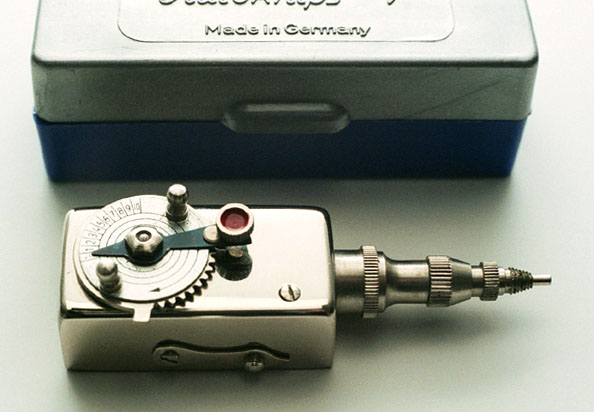
[C312-36A: The German-made Auto-Knips.]
Flash photography with the Pentacon Six
Using the delayed action
Just like the better 35mm SLRs of the period, the Pentacon Six (and the Exakta 66) has a delayed-action mechanism (also sometimes known as a self-timer). This enables you to take photographs in which you wish to appear also. Naturally, it is necessary to mount the camera on a tripod if you want to have full control of the composition of the image. As when using the delayed action control with virtually any other mechanical camera, the procedure is as follows:
Using the delayed action lever with flash does not work. For the flash to fire, the shutter release button must be held down to complete the circuit. The delayed action lever does not do this on either the Pentacon Six or the Exakta 66, so the flash will not fire.
If you want to include yourself in a flash photograph, use a long pneumatic
cable release, or one of these lovely old-fashioned clockwork releases:

[C312-36A: The German-made Auto-Knips.]
|
I am grateful to Steve from California, who wrote to me the following:
Here is the reply that I sent to Steve: I didnít know the answer to your question and wasnít prepared to test on one of my cameras, in case I damaged it, so I rang the manufacturers in Germany and spoke with THE man who is the specialist repairer and maintenance person for the Pentacon Six and he tells me that this is another MYTH about the Pentacon Six! He told me that if you advance the self-timer without having advanced the shutter, it will wind back down part of the way. If you then advance the shutter, the self-timer will finish its trajectory, though the time delay will obviously be a little shorter. I didnít actually ask him what would happen if one pressed the shutter before advancing the film, but when the self-timer isnít set and one presses the shutter release without the shutter being cocked, nothing happens, so I suppose that itís the same here. But why would one press the shutter of a camera without putting it to oneís eye first? Then one would see that the shutter was not cocked. Using a precision mechanical instrument requires methodical working, and setting the self-timer should be the last step, once everything else is ready: shutter cocked, metering done, shutter speed and aperture set, image focussed and of course, camera on tripod (usually) if using the self-timer. Of course, it must be possible to break the Pentacon Six, somehow, just as it is possible to break a Hasselblad, if one is determined to do so and forces things, but this camera is inherently reliable and in my experience less susceptible to inadvertent damage than a Hasselblad 500C or 500C/M (I have both). To read about more myths about the Pentacon Six, click here. No delayed action on the Hasselblad Since 1982 the Hasselblads havenít even had a self-timer,
or delayed-action mechanism, as that year the lens manufacturer, Carl Zeiss
West Germany, switched from using Compur shutters, which had a delayed-action
mechanism, to using Prontor shutters, which do not have one. This
applies to the 500C/M and the SWC/M, to my certain knowledge, and must
apply to any other Hasselblads for which lenses with Prontor shutters are
supplied.
|
To go on to the next section, click below.
Next section (Synchronisation speed with focal
plane shutters)
To go back to the beginning of the flash section, click below and then
choose the section that you want to read about.
Back to beginning of the flash section.
To choose other options, click below.
Home
© TRA April 2002, February 2011